#anti-gallic
Photo
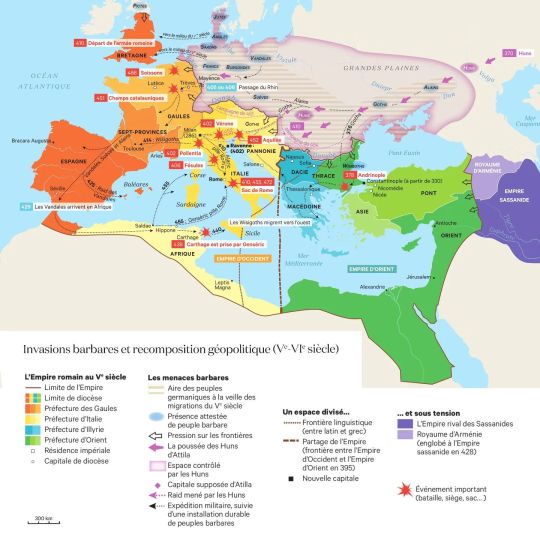
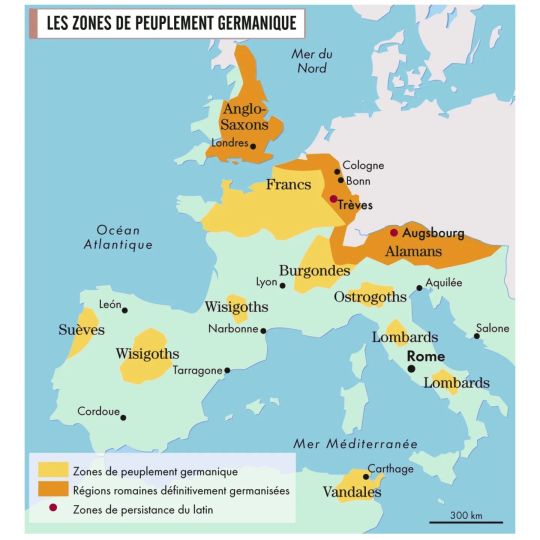
Barbarians and Romans: the geopolitical recomposition of the 5th century.
1 : « Atlas historique mondial », Les Arènes, 2019
2 : « Atlas de Rome et des barbares », Autrement 2018
via cartesdhistoire
The presence of barbarians could not be resolved by force alone, so the emperors chose to address the issue politically. Treaties that settled barbarians in specific regions helped to stop the violence and costly devastation from a fiscal standpoint. Additionally, the barbarians strengthened the imperial army against other barbarians, usurpers, and anti-tax revolts. There was also hope to integrate them into the empire.
During the 5th century, the status of federates recognized by the emperor allowed local elites to cooperate with the barbarians while remaining loyal to Rome. Political reasons (such as the legitimacy of the barbarians' presence granted by the emperor), acculturation (acceptance of Christianity, Latin culture, and many Roman social traditions), and long-standing relations with the Romans facilitated the acceptance of barbarian power, as they often belonged to the same late Roman world.
For example, the Salian Franks entered the Empire around 290 as dedicates in Batavia and settled in Toxandrie in 342. In 451, they allied with Rome against Attila, then against the Burgundians and the Visigoths. At the death of Childeric, Remigius of Reims considered Clovis a natural partner. Similarly, the Goths signed their first treaty with Rome in 332 and regularly helped Rome from 413 to 460 against other barbarians (Alans, Hasdingi Vandals, Suevi), usurpers (Jovinus), Bagaudae revolts (454), and invaders (Attila). They had been in the Empire for a century when they were recognized as independent. The Burgundians signed two treaties as federates around 413 and 442. After 458, their leaders defined themselves as masters of the Gallic militia for more than half a century. The Ostrogoths, on their part, came to Italy at the request of Constantinople.
86 notes
·
View notes
Text


Minisa Whent-Tully
The Whents are such a fun house, they live in a HAUNTED CASTLE and their sigil is a BAT. The Whents are vampires headcanon confirmed (there's a Lady Stoneheart vampire theory here somewhere) .
I didn't really want to portray Minisa as sweet or diminutive. I can't see anyone who grew up in Harrenhall of all places to not have some fangs. You can be a beloved wife and mother and also be creepy AF.
The Riverlands pre-rebellion to me are the epitome of Post-Roman Pre-Anglo Saxon fashion in the Scottish isles. Gallic influences mingling with drapery, rich dyes, and fine metalwork. Post-Rebellion, there's less of an anti-Targ backlash style-wise, simply because there's less of a stark (ha) difference between the Riverlands and KL. Nobles begin to prefer less draping in favour of tighter tailoring and heavier embroidery, but that's about it.
I feel like if anyone would preserve a stylistic time capsule like Druidic face paint for centuries after the conquest, it would be vassal houses surrounding a superstitious and mystical place like Harrenhall.
Rickard-Lyarra Brandon Ned Lyanna Benjen Jon Arya
Minisa Hoster Catelyn Edmure Lysa Robb Sansa Bran Rickon Robin
#asoiaf#valyrianscrolls#minisa tully#minisa whent#game of thrones#got#house tully#house whent#i made a riverlands background! its not that great but i kind of regret not doing one for the previous characters
49 notes
·
View notes
Text
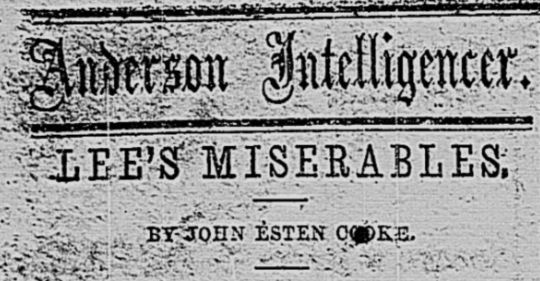
Source: the South Carolina Anderson Intelligencer, 14 October 1868
I will just quote the first half of the article, which has to do with Les Misérables, the second half if pure Confederate apologia. And if you do click through to the source, be warned that it is full of anti-Black racism.
They called themselves “Lee’s Miserables.”
That was a grim piece of humor, was it not reader? And the name had a somewhat curious origin. Victor Hugo’s work, Les Miserables, had been translated and published by a house in Richmond; the soldiers, in the great dearth of reading matter had seized upon it; and thus, by a strange chance the tragic story of the great French writer, had become known to the soldiers in the trenches. Everywhere, you might see the gaunt figures in their tattered jackets bending over the dingy pamphlets “Fantine,” Cosette,” or “Marius” or “St. Denis,” — and the woes of “Jean Valjean,” the old galley slave, found an echo in the hearts of these brave soldiers, immured in the trenches and fettered by duty to their muskets or their cannon.
Singular fortune of a writer! Happy M. Hugo! Your fancies crossed the ocean, and, transmitted into a new tongue, whiled away the dreary hours of the old soldiers of Lee, at Petersburg.
Thus, that history of “The Wretched,” was the pabulum of the South in 1864; and as the French title had been retained on the backs of the Pamphlets, the soldiers, little familiar with the Gallic pronunciation, called the book, “Lee’s Miserables!” Then another step was taken. It was no longer the book, but themselves whom they referred to by that name. The old veterans of the army thenceforth laughed at their miseries, and dubbed themselves grimly “Lee’s Miserables!”
The sobriquet was gloomy, and there was something tragic in the employment of it; but it was applicable. Like most popular terms, it expressed the exact thought in the mind of every one — coined the situation into a phrase.
25 notes
·
View notes
Text

Jacques Delors, president of the European Commission during its most imperial and self-confident years, unwittingly became the Gallic symbol to British eurosceptiques of all they feared and despised about the great European project. This perplexed but did not faze him, especially given that after his departure the structure and aims of the European Union remained much as he had envisaged them during his decade from 1985 in Brussels. Appointed to a record three terms as president, he has claims to be the most significant architect and leader of the European project since its emergence following the second world war.
The irony was that the great achievement of Delors, who has died aged 98, was the creation of a single regulated market for trade, goods and services across the European Union – an idea that Margaret Thatcher, his nemesis, enthusiastically signed up to. However, he wanted to go much further than her and some other European leaders, seeing the concomitant need for a single currency and a more powerful, centralised federalist governing system in a global economy with competing power blocs: “National sovereignty no longer means much. . . voluntary cooperation never works,” he said. “In order to face American and Japanese challenges we need to be supranational” – this before the rise of China as an economic power.
Delors, with his lower middle-class background, his ferocious work ethic, his strong religious faith allied to an economist’s belief in fiscal restraint and anti-inflationary caution, might have been a natural ally of Conservative prime ministers. Thatcher backed his appointment to the commission in 1984, and his subsequent reappointment. But his very Frenchness – his strong accent, his pinched and somewhat rancorous manner, and his Gallic confidence in centralised government – counted against him as the tide of popular opinion on both sides of the Channel started to turn in reaction to economic downturn, job insecurity and rising unemployment. Certainly national governments made sure that no commission president would ever be so powerful again.
What was remarkable was that Delors did not come from the privileged French elite of énarques, graduates of the École Nationale d’Administration, whose expectation is that they will run things, or from a powerful party political powerbase, but had fought his way up through ability, application and hard work. The only child of Jeanne (nee Rigal) and Louis Delors, a grievously wounded veteran of the first world war who had left the rural region of Corrèze in south-central France to become a messenger at the Banque de France in Paris, Jacques was born in the working-class 11th arrondissement of the French capital.
His background – half respectable urban poor, half self-reliant rural peasant – did not turn him into a socialist but encouraged him to become a member of the Jeunesse Ouvrière Chrétienne (the Young Christian Workers) movement (and an able member of its basketball team). Delors’ devout Catholic faith shaped his politics, and although he became a member of the French Socialist party in the 1970s he said later: “I’ve never been fascinated by communism and Marxism – I am undoubtedly the only man on the French left who never has been. I believed one could improve society but not change society.” It was his Catholicism that fuelled his support for collective social responsibility and co-operation.
His education was disrupted by the second world war, and afterwards he was diverted from going to university by his father’s insistence that he should follow him into the Banque de France. Otherwise, he might have become a fashion designer, film director or sports journalist. Instead he worked as a securities manager, studied economics at evening classes and married another staff member, Marie Lephaille, who was of Basque origin, in 1948. The bank wanted to promote him, but in 1953 he accepted a job as an economist with a Christian trade union that appreciated his skill at explaining economic concepts clearly. When, years later, François Mitterrand asked him how he had acquired that skill, Delors replied: “If I am clear, it is because I have had little education. As I am not clever, before understanding something I have to make a huge effort.”
By the late 1960s that fluency and seriousness had taken him into politics, as an adviser to the Gaullist government and then into the Socialist party, tempering its secularism. Under Mitterand he became the government’s economics minister (1981-84), gaining the reputation of saving France from financial meltdown by reining in the socialists’ wildly unrealistic spending policies, curbing inflation and cutting the ballooning budget deficit, despite Mitterand’s cynical havering and the outright opposition of most of his fellow ministers.
He impressed European finance ministers and even eventually the sceptical Mitterand, though not enough to be made prime minister: “Delors,” said the president, “smells of the sacristy.” Instead, when there was a vacancy for the presidency of the commission, he was put up for that job as the acceptable French face of economic realism for leaders such as the German chancellor Helmut Kohl and Thatcher.
The commission, once described as a civil service with attitude (not only administering community policies but proposing and implementing its rules and regulations), was in a state of complacent near-torpor when Delors arrived in January 1985. Within a fortnight, following consultations with national governments, he shook things up with the announcement of plans to launch a European single market over the coming seven years, removing trading barriers and discrimination against foreign competitors. Stasis in decision-making in Brussels was countered by reducing countries’ vetoing powers. In constructing the single market he would have the enthusiastic support of the British Tory internal market, tax and customs commissioner Lord (Arthur) Cockfield.
More clearly than leaders such as Thatcher, who thought of it merely as a freeing up of markets, Delors saw the implications for states’ social and employment policies and, eventually, currencies as well: alarm bells rang when he announced that within a decade 80% of economic legislation, including taxation and social policy, would come from the commission. The single market was, certainly initially, a means of stopping Europe’s relative economic decline in the world, but it would also have wider international benefits. He told the European parliament that the member states would have to learn “to speak with a single voice and act together”, and added: “Are we Europeans capable of it? Whether it concerns currency instability, prohibitive rates of interest, hidden protectionism, a decline in aid to the poorest countries – no, Europe has not known how to lead the way.”
Under Delors, the commission became more forceful and outspoken, but also more tightly governed by the president’s cabinet coterie of mainly French staff. They – like him, but unlike many others in the commission – had a Stakhanovite work ethic and an arrogance in enforcing the president’s will across its departments.
Delors thought of himself as an internationalist, with a penchant for jazz and American films, but he was little travelled and struggled to appreciate national foibles and political differences. His strong French accent when speaking English and his austere and unsmiling appearance seemed to typify the arrogant European bureaucrat to the British tabloids, increasingly adopting the sceptical tone of the Thatcher government. He was wily but also outspoken, not always choosing his words carefully or respecting sensitivities.
In 1988 he told the TUC Congress that the commission would require governments to introduce pro-labour legislation, including a right to training and improved protection for workers. That swung the British left and the trade unions almost overnight in favour of Europe as a bulwark against Thatcherism, but it naturally infuriated the prime minister, who retaliated with a speech in Bruges. “We have not successfully rolled back the frontiers of the state in Britain only to see them reimposed at a European level with a European superstate exercising a new dominance from Brussels,” she said.
Thus was a new Tory trope born, gradually replacing the party’s previous pro-Europeanism, though two years later Thatcher’s “No! No! No!” to Delors and federalism in the Commons was what precipitated her downfall. More demotically, “Up Yours Delors!” was the Sun’s headline response, reflective of a growing identification of the commission president with the ills of Europe.
By the early 1990s, with the single market in place, Delors’ plans for the next stage – the single currency and political union – were causing consternation among voters in other countries besides Britain. His perceived stubbornness was exemplified when he attempted to derail a deal on farm subsidies with the US, holding up a world trade agreement, because he believed it would undercut French agriculture. The commission’s pre-emptive announcements across a range of issues fed into a wider perception of its indifference to national preferences and democratic decisions.
This came to a head with the Maastricht Treaty of 1992, which – over 250 convoluted and constipated pages – outlined the creation of the European Union, explained new modes of governance within it, and detailed steps towards the adoption of the euro through the creation of the European Monetary System. Its passage through the member states, in legislatures and referendums, was fraught: it nearly brought down John Major’s government in the UK, was initially rejected by the Danes, and was only endorsed by the narrowest of margins by the French. The treaty became a symbol of an out-of-touch bureaucracy and commission president, both unable to connect with or explain to Europe’s voters either why the changes were necessary or what their benefits would be.
Delors’ infuriated statements, such as in a speech in Quimper, Brittany, where he asserted that “there’s no place in a democracy for people who call for a non,” only fuelled the mainly rightwing campaigns against the treaty and created resentment about Europe’s creeping interference in national democratic procedures.
Nevertheless, the treaty eventually passed. Delors had wrestled Europe into a new, more unified and federal direction, with the new states of eastern Europe queueing up to join. However, the treaty was also the harbinger of growing difficulties to come, especially as the single currency intially faltered in the following decade.
Delors, by then the longest serving president in the commission’s history, seemed to recognise that his time was now over. “I became the symbol of an idea of Europe which is in the process of vanishing,” he said in December 1993. “I am discouraged to the extent that I can no longer be useful. I can no longer stamp my mark on Europe. It’s finished [and] frankly, I am no longer the man for the job.”
It was assumed that when Delors stepped down from the presidency in 1995 that he would resume a political career in France, perhaps as a socialist candidate for the presidency. But it was not to be. The French elected the Gaullist Jacques Chirac to succeed Mitterrand, and by then Delors was anyway touching 70 and troubled by sciatica. In the EU, the heads of government had had enough of an overweening, over-ambitious commission and replaced Delors with the ineffectual former prime minister of Luxembourg, Jacques Santer – a man with no ambition to impose his will either on colleagues or on the governments of nations larger than his own.
Delors’ ambitions for Europe were hollowed out: even as he retired, the Balkan countries were erupting in ethnic violence that the EU proved powerless to prevent or stop. In a quiet retirement, he still lived unassumingly in a small Paris apartment, emerging not to pronounce on world events but to commentate on the Tour de France.
He and his wife had two children. Their son, Jean-Paul, a journalist, died of leukaemia in 1982 aged 29. Marie died in 2020. Their daughter, Martine Aubry, became a French government minister, mayor of Lille and leader of the French Socialist party (2008-12).
🔔 Jacques Lucien Jean Delors, politician and public servant, born 20 July 1925; died 27 December 2023
Daily inspiration. Discover more photos at Just for Books…?
7 notes
·
View notes
Text
My Style Analysis: Devi in Ben's Dream Part 2

Alright folks we are gonna take another ring around the rosy everything Ben got thinking of this dream.
One thing I kick myself for despite the fact that both Stranger Things and NHIE are Netflix productions is why I didn't see it sooner.
Devi is likely dressed in an updated version of Princess Daphne from the classic arcade game Dragon's Lair, a Don Bluth production.

Yes the archetypal Damsel In Distress whose character design was based on Playboy pinups, who looks like she'd fall out of her lingerie (lots of fashion tape must be used) and part of the Dumb Blonde stereotype that was used do demean conventionally attractive women AND women who didn't fit the mold regardless of physical appeal. And her Knight In Shining Armor? Dirk.

Despite fitting the archetypal notion of the Knight, Dirk is not drawn as desirably as Daphne, part of the reasons many feminists found the games to be sexist (with Space Ace being a marginal improvement given that Kimberly, a redheaded Daphne, is sassy and spunky and is able to take initiative in saving the day) and Daphne is a passive figure in all this.
Now what about ST2 and NHIE? Well....

In the opener to the 2nd Season of the highly popular sci-fi period piece, the boys (Will Byers, Mike Wheeler, Dustin Henderson, and Lucas Sinclair) head over to a 1984 perfect arcade where Dustin tries to best Lucas's high score at the game only to have Dirk killed by the dragon and Lucas gloat about being able to save the blonde beauty. Why is this important?

Because New Girl in Town Max Mayfield ("Mad Max") beat Dustin's high score on Dig Dug and soon Lucas and Dustin are both in competition for the acerbic tomboy's feelings, thus marking a foreshadowing of who gets the girl.
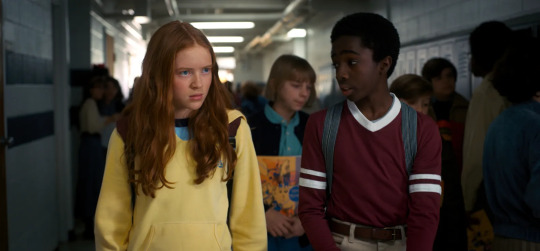

It's Lucas, of course. But despite time zones, episode by episode conflicts, and decades separating the couples, Lumax and Benvi do have a lot in common. Buckle up because we will be talking about how Western Society treats difference in ethnicity, heritage, race, and appearance and gender.
One thing to make clear that the image of the Knight in Shining Armor and the helpless Princess is often obnoxiously Eurocentric, especially of the Gallic or Anglo persuasion. Princess Daphne is tall, leggy, slim and curvaceous with long, blonde hair and blue eyes with a voice high on helium and a babylike demeanor, a kind of innocence attributed to respectable European women that Karens have exploited for generations often to damaging effects; Dirk is meant to stand in as traditionally masculine but hapless enough to be relatable to the (assumed) male players of the game, all he has to do is save the girl to have any shot with her leading to the unfortunate implication that young men are entitled to the opposite gender, especially the ones considered the most desirable but he isn't classically handsome, historically men have been able to get away with not living up to beauty standards by being able to be identified with their talent, intelligence, heroics, finances, economic savvy, work ethic, virility, strong character, sense of humor, or being a decent person. And of course it's been said (and proved) that white men can get away with being mediocre and still scale the ladder of society, whereas his conditionally white and racialized counterparts have to work harder to even take their steps on an often more perilous ladder.


Historically in our society, both members of the Black and Jewish Diaspora have had a....hard time of it: often as targets of derision, fear, violence, and disdain for the jobs they were sentenced to do (often in less "respectable" areas) and this also affected how (and this is not to take away from how insidious anti-Black and anti-Semite misogyny is, go ask Meghan Thee Stallion and Elana Steinberg) men of these groups were depicted: either desexualized and non-threatening to the point of being humiliated or over-sexualized and "out to take our wimmin" and scapegoated because won't someone please think of the children?
Sometimes if they were "lucky", they got to be "the best friend" to the less ethnic white guy who presents as WASPy. They could be attractive (if not more) or charming (if not more) or compelling to watch (if not more) as the hero but don't get the leading man treatment or are the replaceable awesome love interest who are moved aside for the more flawed and relatable white character (look at Courtney B. Vance in Sex and the City); there is also ugggh beauty standards that favor Eurocentric gentile features over non-European features. Dirk is drawn in that classic homely cartoon guy style while both Lucas and Ben are more conventionally desirable to their girlfriends (and many fans of their respective shows) but while Dirk is entitled to Daphne's affections (and by implication, her body), both Lucas and Ben (who are both younger than Dirk) have to not only save the girl but they also have to gentle their way (a term I learned as a kid) by being more emotionally available and being there for their girlfriend's vulnerabilities and be willing to risk heartbreak. Both @urspopinionsareshit (on masculinity and anti-Semitic tropes) and u/absentminded88 on Reddit (on Lucas Sinclair and tropes focusing on African American masculinity) have wrote extensively on these topics but my point still stands that often men of both diasporas were often overlooked as paragons of ideal masculinity.
Now it's one for the ladies!

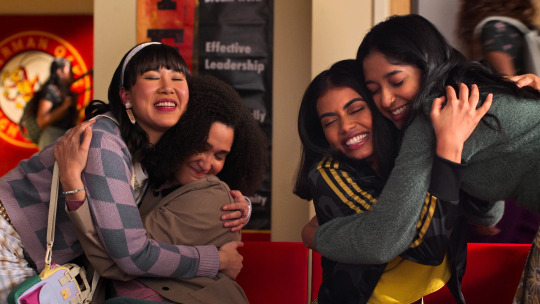
I picked these because Max and Devi have something that poor Daphne lacks: illuminating friendships with other women and looks like I will have to toss a wet mildew blanket into the party.
Let's talk feminine stereotypes and difference! *dodges tomatoes*
It's quite a stretch to suggest that both Max and Devi don't fit a conventional eurocentric blonde beauty as both Sadie Sink (who's also a model) and Maitreyi Ramikrishnan are both pretty girls with expressive eyes with slim figures but yet many women of color and redheaded women were often not considered paragons of beauty (if they weren't being over-sexualized as homewreckers and temptresses) and often not considered feminine due to depictions of their "fiery" tempers at best or being seen as castrating harpies. Max and Devi both struggle with their society's view of how girls should behave, have dealt with trauma, not taking shit from boys or authority figures or even other girls, chafing against certain expectations put on them while trying to navigate femininity away from their mothers (who they have strained relationships with) and with the help of mass media (eep). But ultimately both girls find empowerment in their relationships with other women, finding out how capable they really are even with threatening a man with a weapon or destroying his skateboard, and in their own self-expression and put-upon uniqueness. Whereas Daphne existed to look pretty and adore Dirk (and by extension the assumed cis male player), Max and Devi have agency and ideas with formidable personalities that intimidate their peers and do-nothing adult authority figures. If they need saving, they at least try to resist and are capable of it.
This initiative is reflected in the dream: Devi declares her academic accomplishments and capability are superior to Ben's and that is a turn on for him, she manages to Jedi mind-trick his shirt off, and declares she will take charge of their lovemaking. Perfect combo of sensuality, brains, beauty, and gumption.
Both Lumax and Benvi prove that there is an appeal towards seeing couples not fall into strict gender roles where one is more capable than the other and one has work hard to meet a trophy wife standard and about thirty years after Daphne and Kimberly of Space Ace, we have seen the sassy, vocal, independent love interest role evolve from love interest to being the protagonist/main character of her story.
#women in media#men in media#race in media#never have i ever#stranger things#dragons lair#don bluth#gender roles#white privilege#beauty standards#lumax#benvi#lucas x max#devi x ben#lucas sinclair#max mayfield#devi vishwakumar#ben gross#caleb mclaughlin#maitreyi ramakrishnan#sadie sink#jaren lewison
10 notes
·
View notes
Text
The Long Hall
So I used to do these little link-heavy explainers on my story posts in the y! days, but Tumblr isn't really set up for those in the same way. But I thought this would be a good way to do it and maybe people would be interested, especially because our boys, god love 'em, aren't super focused on the atmospheric and my weird semi-limited 3rd person omniscient narration is... well, weird, I guess. Maybe you want to see what things look like, more or less.
Under the cut: a little description of the Long Hall, some inspiration pictures, and links to sources.
Right, so, we're aware that culturally Ainjir has been constructed with a lot of Celtic/ Gallic influence, but I don't want descriptions of the Long Hall to be quite folded in with the early European/ Germanic (I do not have an opinion on whether there was such a thing as the pre-Roman Germanic people, don't ask) feasting hall, mead hall, big wooden longhouse deal. This isn't because Ainjir doesn't have a feasting culture (it does!), but because the Academy has to be weird about things. That's what's fun about it.
Right, feasting culture is all wrapped in gifts and fealty and all the jazz, which means it's wrapped up in the nobility and the military is - rather famously - anti-nobility, but you've still got a logistical problem and the military (nerds) loves (solving) a good logistical problem. So they can't just build a feasting hall on the Academy grounds (because of The Connotations), and they're not about to persist in having multiple messes scattered around the premises (seems inefficient), so one of the first and largest construction projects (after the Tower, which is a big fuck-you to the royal family specifically and nobility generally) is the Long Hall. They decided to build this almost before they decided to build classroom buildings, which I'm sure is a sign of something. And because this is a very early project, it's a real decision, right - they don't have any finished permanent buildings, the construction they have lined up (including the Tower and the walls) is already a matter of decades, and already costing amounts of money they do not have, so to decide to build this enormous building, and build it specifically out of stone is just like... wow. are we just making shit up now? okay guys. jeez.
So, like, this is in all ways like a longhouse but it is conceptually important to its builders that is is Not That Thing. And it isn't! Because that's the magic of culture. It is a specific type of grandiose architecture that hadn't existed before in Ainjir (Nika relates it to travelers' halls, but these come about because of the Relay which itself comes about after the Academy, and are arguably modeled on the Long Hall, not the other way around - the hospitality culture they represent existed well before that, but not the specific buildings).
So the problem with a lot of these visuals is that they're quite a bit fancier than the Long Hall and they tend to involve a lot more wood, which is not a thing for this building. The temptation would be to relate it to a cathedral like the naves here at the Metz Cathedral or Salisbury Cathedral, but these have a great deal more interior decoration and space (and much bigger windows) - like the ceiling wouldn't be that high and the inside would be much more plain, though the greater use of stone supports and arches is more like the Long Hall, and the outside, leaning towards more Romanesque cathedrals, is more like it (in the student buildings especially, the interiors are very practical and workmanlike, not least because why would they waste the money and effort on cadets, but exteriors really get into Ainjir's love of decoration - bitches are all about that braid and glitter and bric-a-brac).
Perhaps predictably, university dining halls provide some pretty close feelings for what the inside would actually look like/be like to be in. particularly:

The first link below will take you to more pictures of Oxford University dining halls, but Balliol gets closest in terms of scale, and by having a lot of visible brick or stone. The windows are a bit wider than in the Long Hall, and they would be closer to the ground, as there would be no wood paneling, and the floor would be stone. The fact that you can't see the roof in that picture would be kind of apt, because the stone supports up there would be heavily smoke damaged and pretty dark if not black in the Long Hall, which in the winter is warmed with fire pits.
This is Keble College's dining hall, which I think gets closer to the kind of aestheticism Ainjir would have more generally in architecture and also is closer to the proportions of the Long Hall in certain ways.

In the next link, which features several dining halls, you'll see the dining hall at Yale, which really gets the interior architectural shapes I'm imagining better than many others, but being red brick is totally off in terms of light and coloration (and the Long Hall has better windows, get with it Yale). Followed by Christchurch dining hall, which is a bit small and has inverted colors (light stone and dark wood), but atmospherically gets close to what I picture.
I included some other links to more images of different places in the Sources, as well as one link to the Towers of Bologna, which doesn't match visually the composition of castle, but does get the kind of competitive pettiness of the tower building project the Academy undertook. Which at some point I suppose I'll have to resurrect an explainer on, though the really good descriptions of the Palace Tower are in the novel, not the Academy days stories.
Whatever, they'll be going to the palace eventually (it is a major plot point for both eras, after all).
Sources
2 notes
·
View notes
Text
The English disapproval of Mrs Damer's conduct came at a time when lesbianism was identified with foreign influences and with bohemian and artistic behaviour. Marie Antoinette, Queen of France, was named for 'sapphic orgies', the slur combining – in one inclusive accusation – anti-Gallicism, anti-women and anti-monarchy.
"Normal Women: 900 Years of Making History" - Philippa Gregory
#book quote#normal women#philippa gregory#nonfiction#english#disapproval#anne seymour damer#lesbian#foreign influence#bohemian#artistic#marie antoinette#france#sappic orgies#gallicism#women#monarchy
3 notes
·
View notes
Text
中文

02-Student:Department of Chemical 【Chih-Chi Chang】
Home Poster Contest 02-Student:Department of Chemical 【Chih-Chi Chang】
ENTRY NUMBER:02
SUBJECT
Development of Gallic acid/Curcumin-Loaded Microneedles with Anti-oxidant and Anti-inflammatory Effects
DEPARTMENT
Department of Chemical Engineering
PROFESSOR AND STUDENT
Professor:Mei-Chin Chen
Student:Chih-Chi Chang
ABSTRACT
異位性皮膚炎(Atopic Dermatitis, AD)是一種常見的慢性及反覆發炎之皮膚病。當人體自由基過多時造成之氧化壓力,是造成 AD 的重要因素之一。天然多酚類物質可透過捕捉自由基以及活性氧分子,達到降低氧化壓力以減緩 AD 之症狀。本研究利用雙層式微針,包覆兩種親疏水多酚類藥物,設計出 Gallic acid/Curcumin 複合式微針(GA/Cur MN)。針尖層(上層)為包覆疏水性 Curcumin 之聚乳酸‒羥基乙酸共聚物[Poly(Lactic-co-Glycolic Acid), PLGA]層,下層則以Hyaluronic Acid(HA)包覆親水性 GA。當微針刺進皮膚 5 分鐘後,親水性 HA 溶解可快速釋放GA,以抑制發炎的症狀,同時 HA 給予皮膚保水的效果;疏水性 PLGA 針尖,則能夠鑲嵌入皮膚內緩釋 Curcumin,以長效抗氧化並減少給藥次數。
Original URL: 02-Student:Department of Chemical 【Chih-Chi Chang】-Undergraduate Research , NCKU https://en.ur.ncku.edu.tw/book/02-Student:Department+of+Chemical+%E3%80%90Chih-Chi+Chang%E3%80%91/
The copyright belongs to the author. For commercial reprints, please contact the author for authorization, and for non-commercial reprints, please indicate the source.
3 notes
·
View notes
Note
Whats the difference between the north and south of France, culturally
To be honest, France can't be divided between North and South. France is a very unique country because it's on the crossroad of Mediterranean Europe, Northern Germanic & Celtic Europe. Even our language is the hybrid result of all these cultures.
France's population is literally the result of a great replacement mixing of Gallic (natives - who themselves were super diverse) with Romans who invaded them coming from the Mediterranean pool.
Every French kid learn how the last Gallic warrior (Vercingétorix) surrendered to Julius Cesar
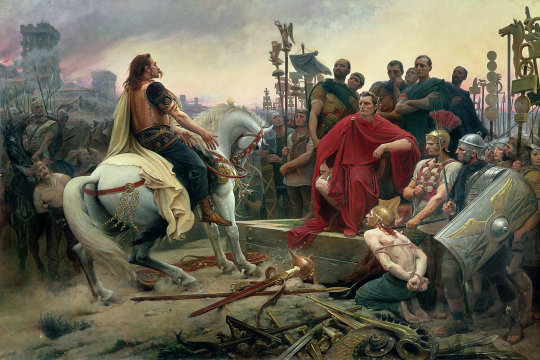
After that, for a good chunk of french History, kings worked to unify the kingdom because regions didn't speak the same language. French as we know is actually "parisien" language and all the other languages slowly fell into irrelevancy (although the last decades the government is trying to revive/protect them after being pressured to do so - some region are VERY defensive of their culture and language ex. the Bretons, Basques, Corses...)

Now to explain the main difference with France that don't solely abide in north/south division, I made you a little drawing

Northern France - violet : super poor. It's a region that historically hosted the country textile manufacturers and fell off because of the deindustrialization. Known for being lovely & homely people (which is true). They eat Camembert with coffee in the morning............
Has a stigma of being inbred and pedophiles because of the many incestuous & pedoscandals and child abduction gravitating this region. The fact that it's on the frontier of Belgium and Netherlands (the capital of childp*rn) has definitively something to do with it
Upper West coast - green : super famous for its cows and milk products (cheese, butter, etc.) and bad weather. Bretons are known to be extremely proud of their cultural heritage and had some terrorist movements against the French government to defend them from their erasure 💀
Paris zone - brown : Paris & the banlieues. Extremely socially diverse. Extreme poverty and extreme wealth. Political & cultural capital of France.
Upper east zone - blue : (I was born there <3) like the north of France, use to be an industrial centerfold of the country (metallurgy - they use the metal from that region to build the Statue of Liberty) and then fell off after deindustrialization.
Its closeness to Luxembourg allows many professional opportunities to work abroad (especially in the banking system). The European Parliament has one of its siege here (Strasbourg) because it's on the crossroad of other European countries
This region used to be German between the two WW therefore many cities have German sounding names (the region became French again after Germany lost WWII).
Growing up there as a kid, I remember there was still a HUGE influence of German culture. I learned German before English (I lost everything though lol)

believe me or not, all of those cities are in France🫡
Lower East coast - black : CULTURED FRANCE. That's where Champagne comes from (région Champagne). Bordeaux is the biggest city of that zone and is known to be a more cultured version of Paris for real connoisseurs 👀
Cote d'Azur - red : zone where the far right makes its highest score. Super rich old people go retire there. Cannes festival. Incredible beach. Most Mediterranean zone of France.
....But there's also Marseille which stands out like a sore thumbs because it's a city a lot of corruption and a HUGE North African/Muslim population. EXTREMELY DIRTY and dangerous (lots o gang violence). Lots of corruption too...
Corsica - pink : they fought for decade for their independence against France lol Still do this day hate France lmao Famous for its anti-France terrorism and killing a French préfet 💀 Are known to bomb the holiday house of French people who constructed there because they don't want "foreigners" to invade their island💀💀

4 notes
·
View notes
Text
hello =^^= !! my name is spencer (any/all pronouns). i’m a louisiana cajun, 17, AuDHD, and queer! — @hornedtrixtr @etherealarrows
hellenic polytheist, sophian & ophite gnostic, theistic luciferian, and animist.
beginner ancestral worker, spiritual alchemist, french and gallic folk practitioner.
interests: kmusic, philosophy, ancient history, linguistics, mythology and theology, anthropology, reading and writing, nature, tv shows supernatural and criminal minds, twilight movies, minecraft and overwatch, and politics.
please keep in mind that i am still learning! if i say or do something that is disrespectful or incorrect, please let me know.
i absolutely love making friends and talking to people so please feel free to send me an ask or dm me! i’m open to giving out my socials to those i trust! my blog is an entirely safe space.
dni: bigot or oppressor of any kind. endo, map, ageplay, pro-ana/mia blogs, anti-recovery, etc. gentile lilith worshipper. disrespects closed practices. includes people who support any of this. also, if you named yourself after a deity, deified mortal, angel, demon, or important mythological figure. if it’s your given name then that’s okay.
my general rule of thumb: if you make me uncomfortable, i’ll block you.

11 notes
·
View notes
Text
B-Goldi Are Destined to Go TikTok Viral
So stock up now.
by Marcio "MZA"
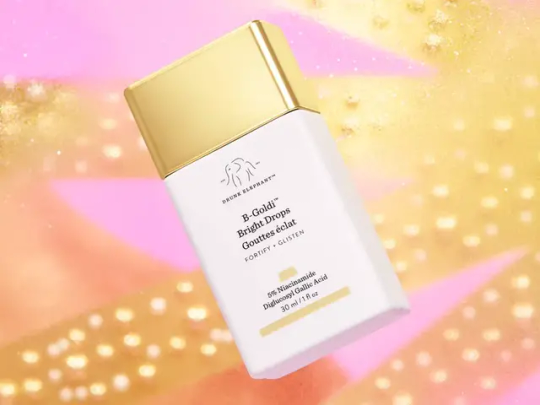
I spent a lot of time on TikTok in early 2023. My toddler son and I were trading the same colds back and forth all winter, and thus I found myself endlessly scrolling through BeautyTok at night while blowing my nose or sipping tea, pretending I was Alix Earle prepping for a night out and not a tired, sick mom in the same stained Gap sweats I’d been wearing for a week. I paid close attention to the “it” products my favorite beauty influencers were using and purchased accordingly, but there was one product in particular that I could never get my hands on, no matter how many alerts I set up: Drunk Elephant’s D-Bronzi Anti-Pollution Sunshine Drops. The bronze drops were a mainstay of so many TikTokers—including Earle—adding a warm glow to their skin either with or without makeup, and they were constantly sold out. The Drunk Elephant section at Sephora was practically a ghost town, so I settled for a similar product and went on my way.
While the D-Bronzi drops are much easier to find these days, I have a feeling that their new baby sister, the B-Goldi Bright Drops ($52), may experience the same surge in popularity—and here’s why.

The Product
Just like the Drunk Elephant’s D-Bronzi Anti-Pollution Sunshine Drops., the Drunk Elephant B-Goldi Bright Drops are versatile, customizable liquid drops housed in a cute square-shaped bottle with a gleaming gold cap. They’re meant to be mixed in with your serum, moisturizer or makeup, or simply worn alone to add a candlelit glow to skin—not a glittery shine.
But the B-Goldi Bright Drops aren’t just pretty to look at; they also offer skincare benefits thanks to the addition of 5% niacinamide, diglucosyl gallic acid, and mulberry leaf extract to help improve clarity and fade dark spots, plus omega oils to nurture the skin.
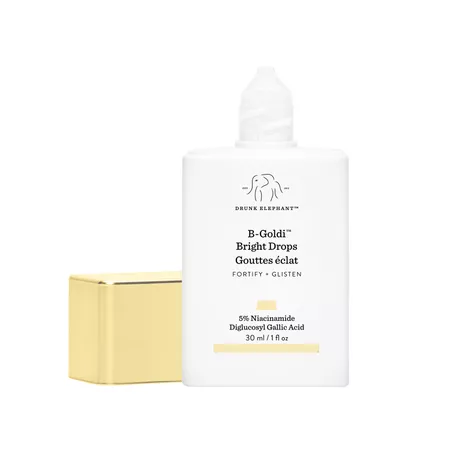
buy on AMAZON $52
My Review
Before we dive into my thoughts, a quick preface to say that I do not have perfect skin like many of the TikTokers I enjoyed scrolling with earlier this year. To say I have problem skin is an understatement. It’s a long story, but I’ve been battling gnarly hormonal acne for a long time and cannot currently be medicated for it, so I wear quite a bit of makeup on a day-to-day basis. I would love to wear the B-Goldi Bright Drops on their own, but it’s not going to happen. Thus, I put them to the test alongside and under makeup.
Drunk Elephant recommends you store the bottle upside down for easier dispensing, and that’s absolutely a tip you should follow. The liquid itself is a gorgeous pale gold with microflecks of light-reflecting pigments, and while they do shimmer under the light, they don’t sparkle. I could barely feel them on my skin post-application (in a good way) and they added a pretty, subtle sheen even on my acne. After massaging in the drops, I applied concealer and powder foundation to my problem areas (chin and nose) but left the rest of my skin bare. I used the excess liquid on my lids, cheekbones and down the bridge of my nose for a little more golden glimmer, and was pleasantly surprised to see how pretty it looked, especially in direct sunlight.

It’s the kind of product you can wear every day and easily incorporate into your routine, especially if it already includes the D-Bronzi or pink-toned O-Bloos Drops; Drunk Elephant recommends mixing or layering them for your own custom blend. I’m converted—and considering snapping up the others while they’re in stock.
1 note
·
View note
Text
Anti cancer fruits
Anti cancer - has polyphenols ( Gallic acid )
Anti inflammatory
Heart healthy
Has vitamin B and C so promotes wound healing
High in iron so helps anemia
Great for skin due to antioxidants (ellagic acid )
Helps reduce stress and insomnia
People could be allergic but low chance
Not suitable for diabetics due to high sugar content!
#nutrition#nutritionist#diet#dieting#dietitian#dietician#healthyfood#healthylifestyle#health#healthy#healing#healthyeating#business#businessideas#businessowner#businesman#healthydubai#fit#fitness#fitdubai#antiinflammatory#anticancer#longan
4 notes
·
View notes
Text
The Indian Fruit Phyllanthus Emblica (Amala) is an Immunity Enhancer and Anti-Obesity Agent: Prefect Fruit for Corona Era

The Indian society has been reverent to nature since ancient times. We bow before mother nature like a God. We worship the sun which lights us up and illuminates the world and drives away all the darkness. We wake up in the morning, touch the earth because we get so much from it, necessary to support life. We worship Tulsi and Peepal because these give us oxygen for 24 hours and are also used in several Ayurvedic medicines. Phyllanthus embilica or Embelica officinalis, commonly known as Indian gooseberry or Amla has a superior therapeutic value in indigenous medicinal system, Ayurveda (Figure 1). The extracts from various parts of Embelica officinalis, especially fruit, contain various phytoconstituents like polyphenols (gallic acid, ellagic acid), different tannins, minerals, vitamins amino acids, fixed oils and flavonoids like rutin and quercetin. The extract or the powder of the fruit has curative effect against a variety of ailments like inflammation, cancer, osteoporosis, neurological disorders, hypertension and many others. These actions are attributed to either regulation of various molecular pathways involved in several pathophysiology or antioxidant property which prevents the damage of cellular compartments from oxidative stress. Amla keeps digestive system on right track and induces appetite. It strengthens the digestive system by converting calories in food stuffs into energy which has a direct bearing on obesity. The ingredients of Amla fight symptoms of fatty liver and high cholesterol and help reduce unwanted fat. Since ancient times, Amla (which is known as nectar fruit in India), is worshiped in India and it is said that 90% of the diseases of the body are cured by eating Amla in any of the forms viz. Morabba, Amla Candy, Chutney, Pickle etc. It is the main constituent of the general Ayurvedic tonic, Chyavanprash, a valued product of several Ayurvedic pharmacies.
Read more about this article: https://crimsonpublishers.com/iod/fulltext/IOD.000620.php
Read more about our journal: https://crimsonpublishers.com/iod/
#peer review journals#open access journals#diabetes mellitus#overweight & obesity#crimsonpublishers llc
0 notes
Text
Understanding Harad: Benefits, Uses, and More

Harad, scientifically known as Terminalia chebula, is a prominent herb in Ayurveda renowned for its therapeutic properties. Commonly referred to as "Haritaki" or "Harad" in Hindi, this herb holds a significant place in traditional medicine due to its diverse range of benefits for health and wellness.
Origins and Traditional Uses
Harad originates from the deciduous forests of India and Southeast Asia. It belongs to the Combretaceae family and has been used for centuries in Ayurvedic medicine. The fruit of the Harad tree is primarily utilized, known for its sour taste and potent medicinal properties.
Key Benefits of Harad
Digestive Health: Harad is renowned for its digestive benefits. It helps in improving digestion, relieving constipation, and promoting regular bowel movements. Its mild laxative properties make it a preferred choice for alleviating gastrointestinal issues.
Antioxidant Properties: Rich in antioxidants like gallic acid and chebulinic acid, Harad helps in neutralizing free radicals in the body. This property supports overall cellular health and may contribute to anti-aging effects.
Immune Support: Harad is known to enhance immune function, making the body more resilient against infections and diseases. Its immunomodulatory effects strengthen the body's defense mechanisms naturally.
Cardiovascular Health: Studies suggest that Harad may have beneficial effects on cardiovascular health. It helps in regulating cholesterol levels and maintaining heart function, thereby promoting a healthy heart.
Detoxification: As a natural detoxifier, Harad aids in cleansing the body by eliminating toxins and purifying blood. This detoxification process supports overall health and vitality.
Hair and Skin Care: Harad is also beneficial for hair and skin health. It helps in preventing hair fall, promoting hair growth, and improving skin complexion when used internally or as a topical treatment.
SarabHerbs®: Your Trusted Source for Quality Herbal Products
At SarabHerbs®, we are committed to bringing you the finest herbal supplements and products derived from nature's bounty. Our range includes high-quality Harad supplements and formulations designed to harness the full potential of this ancient herb. Whether you're looking to enhance digestive health, boost immunity, or improve overall wellness, SarabHerbs® ensures purity, potency, and efficacy in every product.
0 notes
Text
How to Reap Health Benefits of Non-Alcoholic Red Wine

When it comes to maximizing the health benefits of non-alcoholic red wine, we’ve uncovered some intriguing insights that might pique your interest. From its potential to support heart health and aid in managing cholesterol to its antioxidant-rich properties, there’s more to this beverage than meets the eye. But what about those who prefer to explore alternative options for reaping these advantages? Stay tuned as we delve into the realm of resveratrol supplements and other polyphenol-rich sources that could offer similar health benefits without the need for a wine glass in hand.
Health Benefits of Non-Alcoholic Red Wine

When it comes to the health benefits of non-alcoholic red wine, the advantages are backed by concrete research and potential improvements in overall well-being.
Non-alcoholic red wine offers significant benefits for heart health, thanks to its ability to lower blood pressure and manage cholesterol levels effectively. The antioxidant benefits found in non-alcoholic red wine help combat free radicals, contributing to overall health and well-being.
Moreover, the positive impact on sleep quality is notable, enhancing restfulness and promoting better overall health.
Additionally, the management of cholesterol levels plays a crucial role in reducing the risk of heart disease. With these combined benefits, choosing non-alcoholic red wine can be a smart and healthy choice for those looking to improve their cardiovascular health and overall quality of life.
Resveratrol Alternatives for Health Benefits

Exploring alternative sources like pterostilbene, a potent natural compound found in various fruits and nuts, offers a promising avenue for reaping health benefits similar to those of resveratrol.
Pterostilbene supplements have gained attention for their anti-aging benefits, promoting cellular rejuvenation, and potentially extending longevity effects. Studies suggest that pterostilbene enhances cognitive function, providing a holistic approach to overall well-being.
Compared to resveratrol, pterostilbene is better absorbed and remains in the body for longer periods, potentially leading to more pronounced health effects. Its impact on DNA repair, activation of sirtuins and AMPK, and reduction of protein accumulation showcase its potential as a powerful health supplement.
Pterostilbene’s ability to reduce oxidative stress, improve DNA repair mechanisms, and activate antioxidant enzymes makes it an attractive option for those seeking natural ways to combat aging and promote overall health. Incorporating pterostilbene into your routine may offer a range of benefits, from cellular rejuvenation to cognitive enhancement.
Synergy of Polyphenols in Red Wine

Through the combination of various Polyphenol found in red wine, a synergistic effect is observed, contributing to its beneficial impact on human health. Polyphenol interactions within red wine create health synergies, forming powerful antioxidant combinations that offer a range of benefits.
These interactions not only enhance the antioxidant activity of the polyphenols but also amplify their individual effects, providing a more significant overall impact on health. Red wine benefits from the diverse array of polyphenols present, including flavanols like catechin, stilbenes such as trans-resveratrol, flavonols like quercetin, and hydroxybenzoic acids such as gallic acid.
These compounds work together to exhibit anti-inflammatory, anticarcinogenic, and cardio-protective properties when consumed. For those looking to enjoy the advantages of polyphenols without alcohol, non-alcoholic alternatives like supplements can provide similar benefits.
Exploring these options can help individuals incorporate the health-promoting aspects of red wine polyphenols into their daily routines effectively.
Discover Raghas Non-Alcoholic Red Wine
For those looking to enjoy the benefits of red wine without the alcohol, Raghas Non-Alcoholic Red Wine offers a perfect solution. Made from organically grown grapes, this wine provides the rich taste and health benefits of traditional red wine, without the alcohol content. Ideal for health-conscious individuals, Raghas Non-Alcoholic Red Wine allows you to indulge in the flavor and antioxidants that red wine is renowned for, ensuring a delightful and beneficial experience. To learn more about this exceptional product, visit Raghas Organic Non-Alcoholic Red Wine.
Frequently Asked Questions
How to Get the Benefits of Red Wine Without the Alcohol?
When looking to enjoy the benefits of red wine without the alcohol, we can explore alcohol-free options rich in resveratrol. These alternatives offer health advantages, antioxidant content, and satisfying flavor profiles, all promoting well-being through moderate consumption.
How Healthy Is Non-Alcoholic Red Wine?
We enjoy the antioxidant benefits of red wine alternatives like non-alcoholic options. They promote heart health with their resveratrol content. Non-alcoholic red wine is a healthy choice, offering various health benefits without the drawbacks of alcohol.
Does Non Alcoholic Wine Still Have the Same Health Benefits?
Non-alcoholic wine still offers similar health benefits as traditional red wine. It lacks alcohol content but maintains high antioxidant levels and nutritional value. Studies show comparable cardiovascular benefits between alcoholic and non-alcoholic versions, indicating their effectiveness.
How to Drink Red Wine for Health Benefits?
When it comes to reaping the health benefits of red wine, we explore various options like Itadori tea or resveratrol supplements. Incorporating these red wine alternatives can offer antioxidant protection, lower blood pressure, and improve heart health.
Conclusion
Overall, incorporating non-alcoholic red wine or resveratrol alternatives into your daily routine can have numerous health benefits, from improving heart health to boosting antioxidant levels.
Whether enjoying a glass with meals or exploring supplements like grape seed extract, these choices can positively impact your well-being.
So why not raise a toast to your health with a glass of non-alcoholic red wine or a resveratrol supplement today?
Cheers to a healthier you!
Visit Raghas Non-Alcoholic Organic Red Wine to learn more about our products and join our community of happy customers.
#organic#healthcare#health#red wine#wine#Raghas Non-Alcoholic Organic Red Wine#Organic Red Wine#Non Alcoholic Wine#Health Benefits
1 note
·
View note
Text
Top 10 Benefits of Triphala
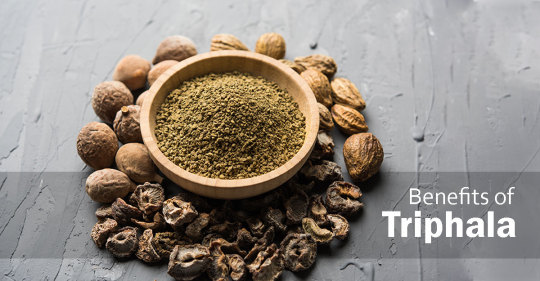
Triphala has long been seen as an invaluable ingredient to holistic healthcare practices. Though it originated in India, its benefits continue to captivate modern health practitioners today with regards to supporting various aspects of well-being and overall wellness. But exactly what is Triphala, and why can it aid on our path towards living healthier lifestyles? Explore this blog through the top 10 benefits of Triphala and how it impacts various aspects of health.
What is Triphala?
Triphala (or “three fruits”) is an ancient Indian herbal blend composed of amalaki, bibhitaki and haritaki fruit extracts and can help support digestion, well-being and potentially more benefits in Ayurveda. It is available in powders, capsules, oil or extract forms – its benefits could potentially aid digestion while simultaneously reducing inflammation, increasing immunity levels and providing powerful antioxidant protection.
Uses of Triphala
It is described as a tridoshic Rasayana in Ayurveda and Triphala is widely used in many health conditions because of its following properties:
laxative
anti-inflammatory
antiviral
Blood purifying
analgesic
anti-arthritic
hypoglycemic
anti-ageing
antibacterial
Benefits of Triphala
Here are the top 10 benefits of Triphala:
Anti-inflammatory Properties
Triphala, an Ayurvedic herbal blend, packs anti-inflammatory power! Studies suggest it reduces inflammation markers, protects cartilage, and even outperforms conventional meds. While promising, more research is needed to confirm its effectiveness in humans.
Protection against Dental Diseases and Cavities
Triphala, an Ayurvedic herbal mix, holds potential against dental woes. Its anti-inflammatory and antimicrobial properties might combat plaque buildup, harmful bacteria, and even inflammation linked to gum disease. Studies suggest it could reduce cavity risk and enhance oral health.
Aid in Weight Loss
Some studies show increased fat loss, especially belly fat, in animals taking Triphala. However, human evidence is limited and inconclusive. Its potential mechanisms, like improved digestion and metabolism, may help to reduce weight. Remember, weight loss primarily relies on calorie balance and lifestyle changes: Triphala might offer support but don’t expect magic results.
Natural Laxative
Triphala provides natural laxative effects through its special combination of fruits. Each fruit provides different actions: Amalaki stimulates gut movement; Bibhitaki softens stool and Haritaki cleans and tones the colon; together these three fruits promote regularity while relieving constipation symptoms – although individual results may differ and excessive use could potentially become habit-forming or lead to dependence; listen to your body, prioritize diet changes as necessary and consult a healthcare provider if symptoms continue.
Digestive Health
Triphala, an Ayurvedic herbal blend, supports digestive health in several ways. It stimulates digestion, softens stool and cleanses the colon with its mixture of fruits. Studies suggest it could even balance gut bacteria levels which might reduce bloating or constipation symptoms – lifestyle and diet adjustments should always be included as integral elements in maintaining overall digestive wellness.
Antioxidant Properties
Triphala packs an antioxidant punch! Gallic acid and polyphenols work to neutralize free radicals found in your body and protect cells against damage; this could provide protection from various health problems; further human studies will need to take place before conclusively verifying its antioxidant effects and exact benefits can be seen from Triphala use.
Skin Health
CBD’s(cannabidiol) antioxidant and anti-inflammatory properties could combat free radicals that accelerate skin aging while healing wounds faster; some studies even indicate its use to address acne breakouts; however, evidence on humans remains limited and inconclusive, with topical application or oral consumption producing mixed results; more research must be completed to ascertain both effectiveness and safety for all users.
Respiratory Health
Its anti-inflammatory and expectorant properties could help ease congestion, soothe irritated airways, and even reduce mucus production. Studies suggest benefits for conditions like asthma and bronchitis. Human studies are crucial to confirm its effectiveness and safety for everyone.
Immune System
Triphala Has Antioxidant Properties that May Enhance Immune System Triphala contains antioxidant properties and has been found effective at reducing inflammation. This in turn has the ability to boost immune function; studies have also indicated triphala supplements increase activity of natural killer cells which helps boost our ability to fight infection more quickly and easily...
0 notes